-
Shopping Bag
-
Sorry, there are no items in your basket
-
SMART SEARCH
DIAMOND GUIDE
The four C's and beyond
At Pravins diamonds are our favourite gemstone and indeed our speciality. Choosing the right diamond takes experience, skill and time. There are many different factors to consider, including the four C’s, as you’ll see below. But you can relax in the knowledge that Pravins select only those diamonds that have genuine sparkle and life and which truly befit a piece of Pravins jewellery.
Carat
A diamond's weight is measured in units called carats, each equivalent to approximately one fifth of a gram. The word derives from the name for the tiny seeds of the carob tree, which are naturally uniform in size and weight and therefore made the perfect measurement for weighing diamonds in the ancient Middle East.
A carat is often expressed in points (1/100ths of a carat) so that a half-carat diamond measures 50 points. For well-cut round brilliant cut diamonds, the relationship between carat-weight and diameter can be shown in the diagram.
A diamond's weight is measured in units called carats, each equivalent to approximately one fifth of a gram. The word derives from the name for the tiny seeds of the carob tree, which are naturally uniform in size and weight and therefore made the perfect measurement for weighing diamonds in the ancient Middle East.
A carat is often expressed in points (1/100ths of a carat) so that a half-carat diamond measures 50 points. For well-cut round brilliant cut diamonds, the relationship between carat-weight and diameter can be shown in the diagram.
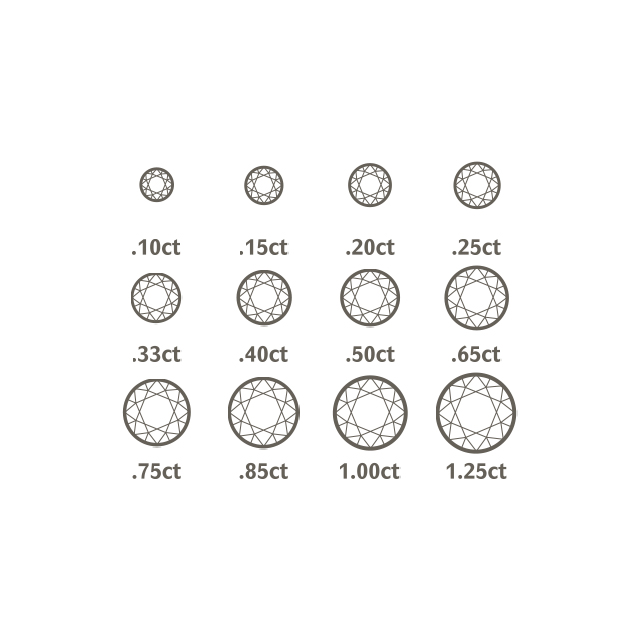

Cut
The term cut is used to describe the accuracy of the angles and proportions of the facets of a polished diamond, compared against a set of ideal measurements. This accuracy governs the interaction between the diamond and light, greatly determining the diamond’s overall appearance. Put simply, more accuracy equals greater brilliance.
Cut is the only one of the four C’s that is influenced by man. Every gem-quality diamond in the world has been carefully cleaved, cut and polished by hand using experienced eyes and traditional techniques.
The term cut is used to describe the accuracy of the angles and proportions of the facets of a polished diamond, compared against a set of ideal measurements. This accuracy governs the interaction between the diamond and light, greatly determining the diamond’s overall appearance. Put simply, more accuracy equals greater brilliance.
Cut is the only one of the four C’s that is influenced by man. Every gem-quality diamond in the world has been carefully cleaved, cut and polished by hand using experienced eyes and traditional techniques.
Pravins generally look for diamonds with ‘excellent’ cut gradings and we carefully check a whole range of additional cut features, all to ensure the highest standards. Our teams will be happy to provide more information on our additional checks.
An important example of how cut can affect a diamond’s brilliance is the depth (in brilliant-cut diamonds). A well-cut diamond with the correct depth will allow the maximum amount of light entering through the top of the diamond to be reflected back to the viewer, resulting in a high level of brilliance and fire.
An important example of how cut can affect a diamond’s brilliance is the depth (in brilliant-cut diamonds). A well-cut diamond with the correct depth will allow the maximum amount of light entering through the top of the diamond to be reflected back to the viewer, resulting in a high level of brilliance and fire.
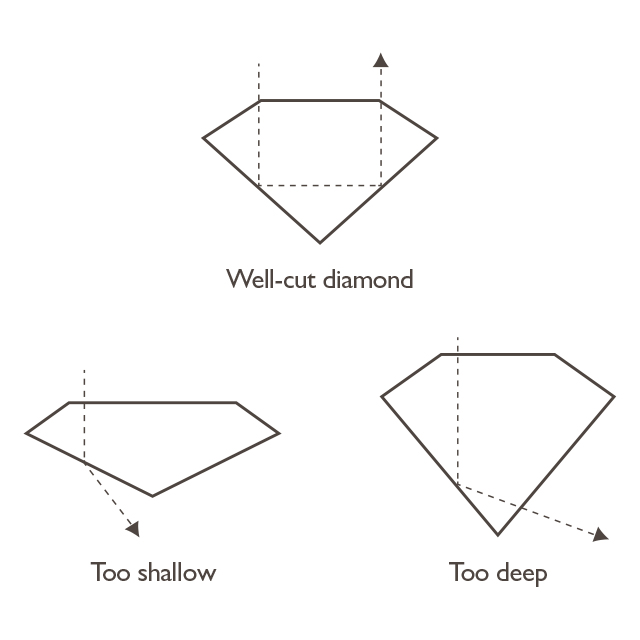
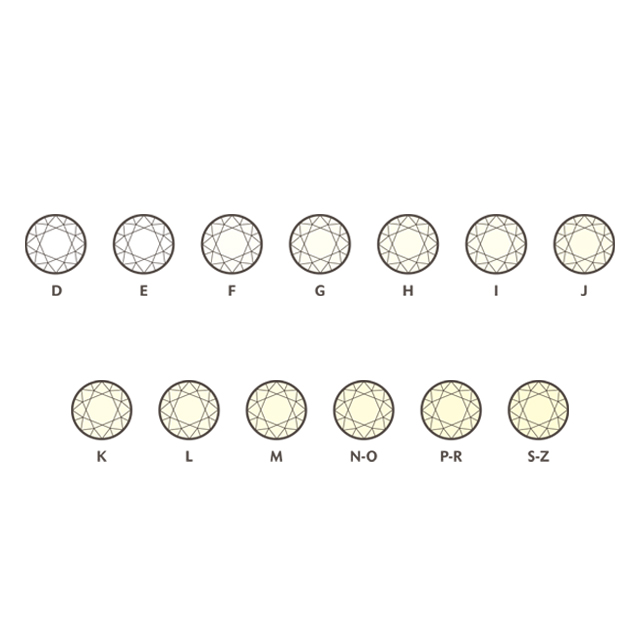
Colour
This is arguably the most important factor to consider, as a diamond’s colour is so readily visible. With the exception of fancy-coloured diamonds, as little colour as possible is considered the most desirable.
Colour is normally graded using the GIA scale from D to Z, as shown on the right. The whitest diamonds (colours D to F) are extremely rare and very much sought-after. The slight trace of yellow found in most diamonds is caused by the presence of nitrogen within the atomic structure of the diamond.
Pravins generally only source diamonds ranging from colours F to H, although we’re happy to source other colours on request.
This is arguably the most important factor to consider, as a diamond’s colour is so readily visible. With the exception of fancy-coloured diamonds, as little colour as possible is considered the most desirable.
Colour is normally graded using the GIA scale from D to Z, as shown on the right. The whitest diamonds (colours D to F) are extremely rare and very much sought-after. The slight trace of yellow found in most diamonds is caused by the presence of nitrogen within the atomic structure of the diamond.
Pravins generally only source diamonds ranging from colours F to H, although we’re happy to source other colours on request.
Clarity
The passage of light through a diamond can be affected by the presence of small natural marks known as inclusions. Clearer diamonds are far rarer and more valuable than those with many or large inclusions.
A diamond’s clarity is usually recorded by the clarity scale shown on the left. At Pravins we generally stock diamonds with a minimum grading of SI1, however we carefully check a whole range of additional clarity features such as milkiness and graining.
It is important to note that inclusions come in a range of colours and sizes and can be located anywhere in the diamond, so this is a really critical factor to consider carefully. Our teams will be happy to provide more detailed information on this subject.
The passage of light through a diamond can be affected by the presence of small natural marks known as inclusions. Clearer diamonds are far rarer and more valuable than those with many or large inclusions.
A diamond’s clarity is usually recorded by the clarity scale shown on the left. At Pravins we generally stock diamonds with a minimum grading of SI1, however we carefully check a whole range of additional clarity features such as milkiness and graining.
It is important to note that inclusions come in a range of colours and sizes and can be located anywhere in the diamond, so this is a really critical factor to consider carefully. Our teams will be happy to provide more detailed information on this subject.
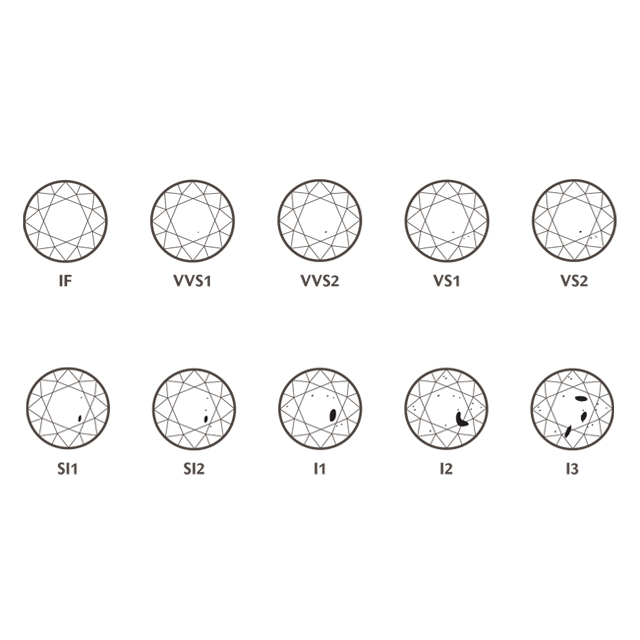
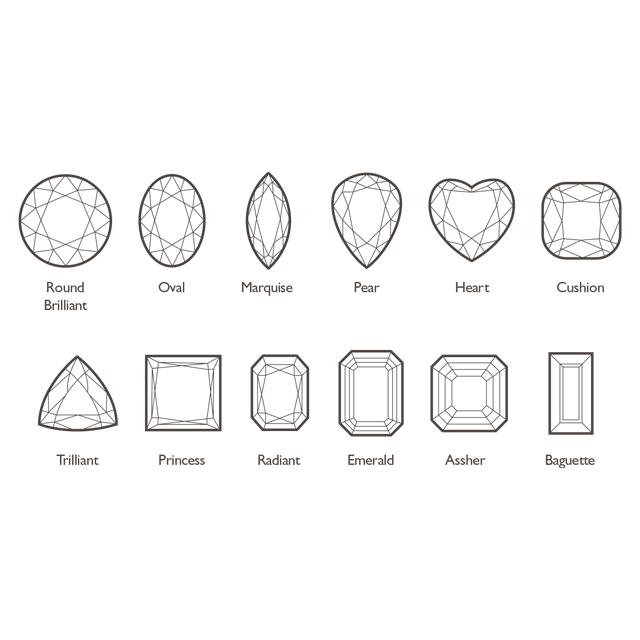
Shape
The choice of shape is very much a personal choice. The most popular shapes are as shown in the diagram on the right.
A diamond’s shape is sometimes also referred to as the cut, which can be confusing.
For more information about the different diamond shapes, visit the Pravins Journal.
The choice of shape is very much a personal choice. The most popular shapes are as shown in the diagram on the right.
A diamond’s shape is sometimes also referred to as the cut, which can be confusing.
For more information about the different diamond shapes, visit the Pravins Journal.
Fluorescence
This refers to the visible light some diamonds emit when exposed to ultraviolet rays, most commonly in daylight. Around a third of all diamonds display some degree of fluorescence and the light emitted can sometimes cause the diamond to display a milky haze or a blue colour.
At Pravins our diamond experts assess all diamonds above 0.30ct carefully to assess whether fluorescence is present and whether it will affect the appearance of the diamond.
This refers to the visible light some diamonds emit when exposed to ultraviolet rays, most commonly in daylight. Around a third of all diamonds display some degree of fluorescence and the light emitted can sometimes cause the diamond to display a milky haze or a blue colour.
At Pravins our diamond experts assess all diamonds above 0.30ct carefully to assess whether fluorescence is present and whether it will affect the appearance of the diamond.
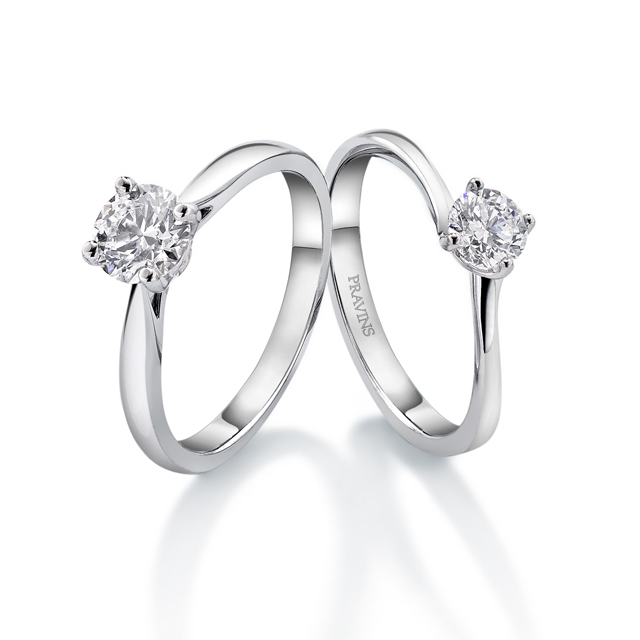
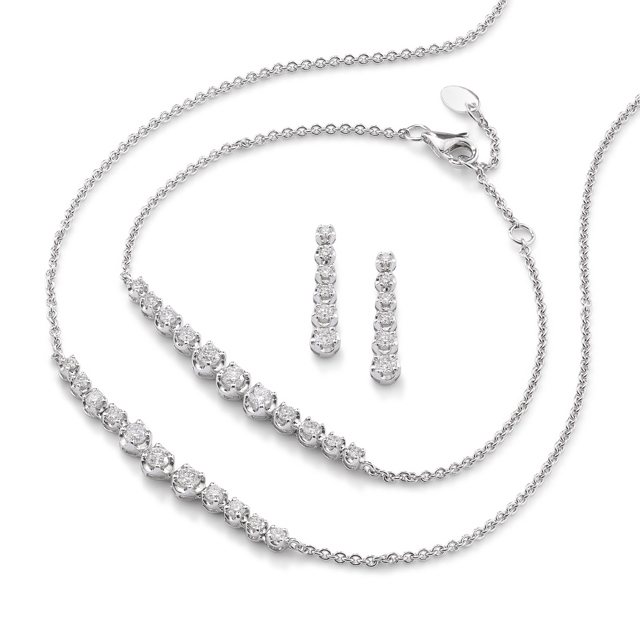
Certification
Sometimes described as the fifth C, certification refers to the process of grading an individual diamond to assess its various characteristics in laboratory conditions using specialist equipment.
Laboratory certificates are available for most diamonds over 0.30ct. Clients usually seek a laboratory certificate for additional reassurance and a record of the characteristics of their diamond.
Bear in mind that some laboratories are more renowned than others, with the Gemmological Institute of America (GIA) the most predominant. Also, the presence of a certificate is not in itself a guarantee of quality. In our opinion, nothing beats taking the time to have a good look at your diamond close up.
Sometimes described as the fifth C, certification refers to the process of grading an individual diamond to assess its various characteristics in laboratory conditions using specialist equipment.
Laboratory certificates are available for most diamonds over 0.30ct. Clients usually seek a laboratory certificate for additional reassurance and a record of the characteristics of their diamond.
Bear in mind that some laboratories are more renowned than others, with the Gemmological Institute of America (GIA) the most predominant. Also, the presence of a certificate is not in itself a guarantee of quality. In our opinion, nothing beats taking the time to have a good look at your diamond close up.
Provenance
Pravins ensure that all our diamonds suppliers are carefully vetted to ensure compliance with The Kimberley Process Certification Scheme. We take every possible step to avoid diamonds of unclear provenance.
All diamonds sold by Pravins are guaranteed to be natural and free of any enhancement or treatment.
Pravins ensure that all our diamonds suppliers are carefully vetted to ensure compliance with The Kimberley Process Certification Scheme. We take every possible step to avoid diamonds of unclear provenance.
All diamonds sold by Pravins are guaranteed to be natural and free of any enhancement or treatment.
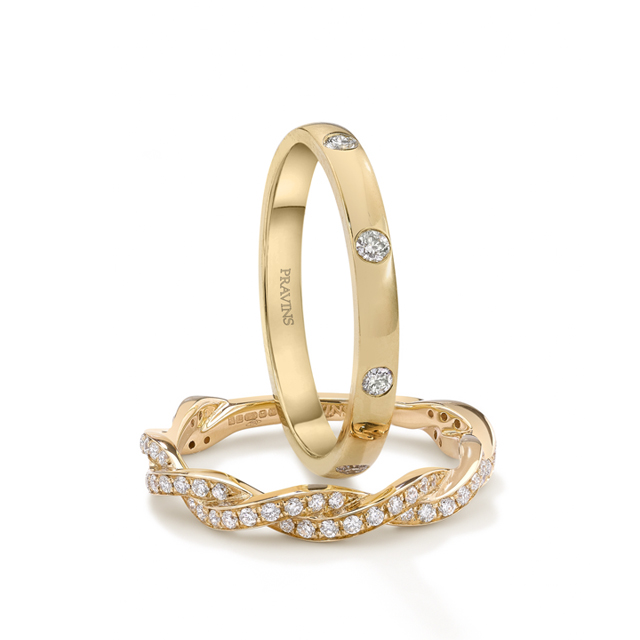
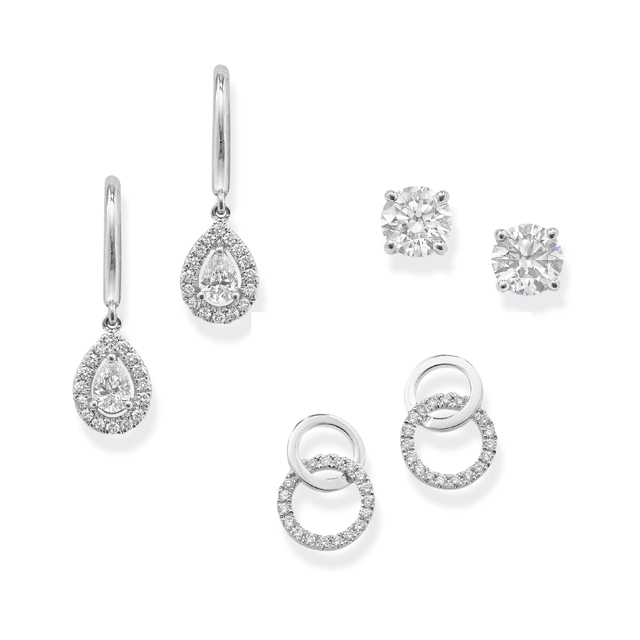
Confidence
Pravins’ diamond experts also consider many other factors such as finish grade and symmetry - and most importantly simply whether or not the diamond ‘speaks’ to us.
Selecting the right diamonds is a slow and complicated process and we rely heavily on the skills and relationships we’ve built up over five decades.
All this care and attention is given with just one singular aim - selecting the finest diamonds, deserving of Pravins rings and jewellery for our valued clients.
Pravins’ diamond experts also consider many other factors such as finish grade and symmetry - and most importantly simply whether or not the diamond ‘speaks’ to us.
Selecting the right diamonds is a slow and complicated process and we rely heavily on the skills and relationships we’ve built up over five decades.
All this care and attention is given with just one singular aim - selecting the finest diamonds, deserving of Pravins rings and jewellery for our valued clients.